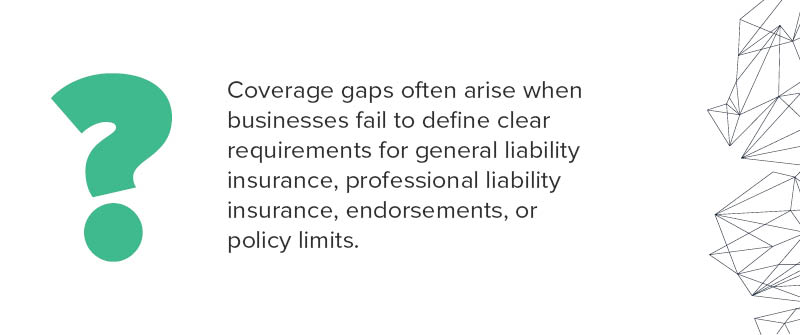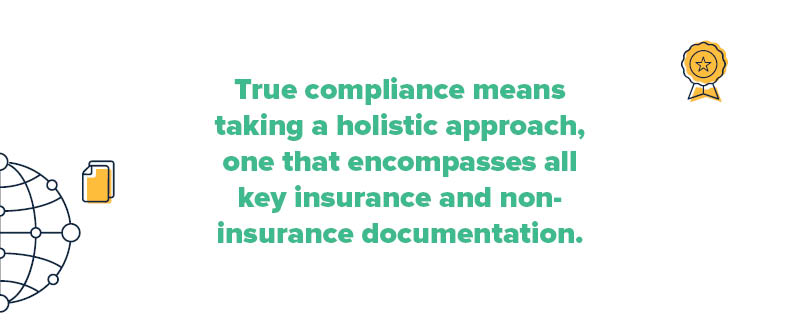
If you’re managing vendors, contractors, or other third-party relationships, you already know how complicated COI (Certificate of Insurance) compliance can be. COIs serve as proof that the parties you work with have the necessary insurance coverage to protect your business from liability. But here’s the thing: COI compliance is just the tip of the iceberg when it comes to third-party insurance risk management.
Many organizations focus on collecting insurance certificates without realizing that effective compliance requires a more comprehensive approach. It’s not just about insurance documents; effective compliance ensures your business is protected from risk, meets insurance requirements, and builds trust with partners. Still, many organizations struggle with common COI compliance mistakes that can lead to costly liabilities and reputational damage.
By addressing the key pitfalls outlined below, you’ll not only tighten your compliance process but also reduce risks, improve collaboration, and create a more efficient workflow for your team.
1. Ignoring Expiration Dates and Renewals
One of the most frequent missteps in COI compliance is failing to track expiration dates or renew coverage details on time. It’s a common story: your vendor’s COI expires, and you don’t even realize it until an incident occurs. This oversight leaves your business exposed, as you won’t have the proper insurance policy in place to confirm active insurance at the time of loss. COIs only prove compliance for a set period of time. Once a certificate expires, you’re exposed to potential liabilities if a vendor’s coverage lapses.
Unfortunately, manually managing expiration dates and renewals is time-consuming and error-prone, especially when multiple vendors are involved. Missing an expiration notification could result in uncovered risks and financial loss.
And it’s not just about COIs. Whether it’s policy endorsements, subcontractor agreements, or liability waivers, failing to stay on top of renewals for all key documents is a recipe for gaps in compliance.
The Fix:
Set up automated notifications to track COI and document expiration dates or better yet leverage an AI-powered compliance platform that automates the tracking of expiration dates. With automated notifications and reminders sent well in advance, vendors and contractors can keep their documents current without the need for countless follow-ups. This ensures your organization is always covered and eliminates the stress of managing renewals manually.
2. Misunderstanding Coverage Requirements
Not all insurance is created equal, which is why proper COI compliance involves more than just collecting a document and checking a box. It’s not enough to just collect COIs; you also need to ensure the coverage aligns with your business’s specific needs. Coverage gaps often arise when businesses fail to define clear requirements for general liability insurance, professional liability insurance, endorsements, or policy limits. This can lead to a false sense of security and leave you vulnerable to risks that the submitted policies don’t cover.

Many organizations fail to ensure that the policies reported on COIs actually meet their coverage requirements. For example, a vendor may lack sufficient policy limits, the necessary additional insured endorsements, or even key protections like worker’s compensation.
This misunderstanding isn’t limited to COIs. Non-insurance documentation, such as indemnity clauses in contracts, also needs to align with your specific risk management strategy. If these documents don’t reflect your needs, you could be left unprotected in a dispute or claim.
The Fix:
Start by clearly defining your insurance coverage requirements for all third parties. Establish minimum limits for liability, include additional insured mandates, and verify that related documents like endorsements and waivers match the COI details. Using compliance tools like AI-driven platforms streamline coverage validation by comparing COIs against predefined requirements automatically. They flag discrepancies like missing endorsements or insufficient coverage limits, enabling you to address non-compliance immediately. With detailed insights, you can ensure every vendor meets your standards from the start, minimizing risk exposure.
For non-insurance compliance, consult with legal experts to align terms in contracts or agreements with your company’s risk mitigation strategy.
3. Relying on Outdated Tracking Tools
Are you still managing COI compliance in spreadsheets, email threads, or paper filing systems? If so, you’re not alone—but you’re also taking unnecessary risks. Many organizations still use spreadsheets or outdated methods to manage COI compliance. While these approaches may work for a small number of vendors, they quickly become unmanageable as your operations grow.
Manual tracking increases the risk of human error, overlooked deadlines, and lost communication with vendors. Think missed renewal dates, misplaced documents, or difficulty scaling operations as you onboard more vendors. Worse yet, these outdated methods don’t provide the insights or automation needed to manage COI compliance efficiently, leaving your organization reactive instead of proactive.
The Fix:
Take the next step by adopting AI-driven third-party business insurance compliance software. These platforms go beyond simple document storage to create a fully collaborative ecosystem. They enable you and your third-party partners to seamlessly track, share, and update information, ensuring everyone stays aligned. With AI keeping tabs on document changes, deadlines, and gaps, you’ll maintain visibility across all workflows.
This collaborative approach not only saves time but also minimizes misunderstandings, delivering a seamless experience for you and your vendors.
4. Not Verifying the Authenticity of COIs and Supporting Documents
Assuming that every COI and document submitted by a vendor is valid and meets your requirements can lead to serious oversight. It’s not uncommon for COIs to be incomplete, forged, or lacking specific endorsements you’ve requested. It’s a mistake to assume all submitted COIs are valid and accurate. Vendors may unknowingly or deliberately provide COIs with errors, missing endorsements, or insufficient policy limits. Failing to cross-check these details can expose your organization to risks that become apparent only after a claim arises.
Similarly, non-insurance compliance documents like hold harmless agreements or subcontractor contracts may contain errors or outdated terms that put your business at risk. Neglecting to verify these documents’ authenticity (or taking them at face value) could result in compliance gaps.

The Fix:
Build a robust review process to validate COI details, including insurance limits, endorsement forms, and the policies’ effective dates. Automated validation is key to ensuring the authenticity of COIs and related documents. AI-powered systems verify policy details, cross-check endorsements, and alert you to inconsistencies or incomplete documents. By eliminating guesswork and relying on real-time authentication, you can confidently approve only fully compliant submissions.
Additionally, apply the same diligence to related agreements and contracts. Legal professionals or compliance tools can help ensure these documents are accurate, complete, and aligned with your risk requirements.
5. Treating Compliance as a One-Way Process
Compliance isn’t something you do to vendors; it’s a collaborative effort that requires alignment, transparency, and ongoing communication. Unfortunately, many businesses treat compliance as a transactional process, focusing solely on collecting documents instead of fostering a more cooperative relationship. This short-sighted approach often results in disjointed communication, delays in acquiring updates, and inefficiencies that not only frustrate vendors but also increase overall risk exposure.
For example, when vendors are left out of the loop or unclear on requirements, they may submit incomplete or incorrect COIs, causing unnecessary back-and-forth and delaying compliance approvals. Misaligned expectations can lead to friction, strained relationships, and even non-compliance if deadlines or requirements aren’t clearly communicated. This lack of collaboration can also make it harder to identify and address compliance gaps, leaving your organization vulnerable to risks that could have been mitigated with proactive engagement.
The Fix:
An AI-powered compliance platform transforms this dynamic by fostering a truly collaborative environment where vendors play an active role in the compliance process. These systems enable shared workflows, allowing vendors to independently upload, review, and update their documents through a centralized platform. Automated notifications ensure that everyone stays informed about deadlines, missing documents, or required updates, reducing the need for manual follow-ups and eliminating misunderstandings.
Transparent, real-time communication established through these tools builds trust and encourages buy-in from vendors. When they understand the process, feel involved, and are provided with intuitive tools to stay compliant, they are far more likely to meet expectations without issue. This alignment not only strengthens vendor relationships but also reduces conflict and inefficiencies that could otherwise slow down your operations.
AI platforms can take collaboration a step further by providing predictive and intelligent insights, allowing businesses to manage compliance proactively. For instance, patterns in non-compliance, such as repeated issues with a specific vendor’s coverage limits or missing endorsements, are automatically highlighted. This enables teams to address problems preemptively rather than reacting after a risk has materialized. Additionally, consolidated dashboards allow all stakeholders to see and track compliance progress in real time, ensuring strategic alignment across internal teams and external partners.
By treating compliance as a two-way relationship rather than a box to check, businesses can transform an often tedious process into a streamlined, strategic advantage. Not only does this approach minimize risk, but it also fosters a culture of partnership and accountability. When combined with the capabilities of modern AI-driven systems, compliance becomes more than just a protective measure; it’s a tool for building stronger, more effective vendor relationships and driving operational success.
Build a Smarter Future for your COI Compliance and Third-Party Risk Management Strategy
By addressing these five common mistakes, you can transform your COI compliance process into a streamlined, proactive system that reduces your third-party risk and saves time. While COI compliance is a critical component of managing third-party risk, it’s important to recognize that it doesn’t exist in a vacuum. True compliance means taking a holistic approach, one that encompasses all key insurance and non-insurance documentation.

By addressing the common COI compliance mistakes outlined above, you can protect your business from liability and streamline your operations. Pair this with ongoing monitoring, automated tools, and a modernized approach to document management, and you’ll transform compliance into a strength—not a chore. Leveraging AI-driven tools can ensure accuracy, enable meaningful collaboration with your third parties, and keep your compliance airtight—no matter how many vendors or documents you’re managing.
If COI compliance feels overwhelming, it’s time to rethink your process. The right tools and strategies can help you maintain accuracy, reduce risk, and keep your operations running smoothly. Don’t wait until mistakes cost you—instead, take action and ensure your compliance is airtight. Reach out today to book a demo!